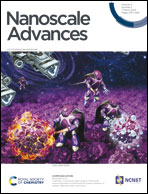A mesoporous ternary transition metal oxide nanoparticle composite for high-performance asymmetric supercapacitor devices with high specific energy†
Abstract
We report on the optimized fabrication and electrochemical properties of ternary metal oxide (Ti–Mo–Ni–O) nanoparticles as electrochemical supercapacitor electrode materials. The structural, morphological, and elemental composition of the fabricated Ti–Mo–Ni–O via rapid breakdown anodization are elucidated by field emission scanning electron microscopy, Raman, and photoelectron spectroscopy analyses. The Ti–Mo–Ni–O nanoparticles reveal pseudocapacitive behavior with a specific capacitance of 255.4 F g−1. Moreover, the supercapacitor device Ti–Mo–Ni–O NPs//mesoporous doped-carbon (TMN NPs//MPDC) device exhibited a superior specific energy of 68.47 W h kg−1 with a corresponding power density of 2058 W kg−1. The supercapacitor device shows 100% coulombic efficiency with 96.8% capacitance retention over 11 000 prolonged charge/discharge cycles at 10 A g−1.



 Please wait while we load your content...
Please wait while we load your content...